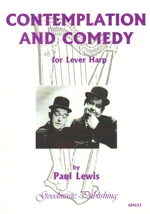
THOUGHTFUL MOMENT: A wistful, lyrical melody - a study in legato playing.
GENTLE INTERLUDE: A dreamy, romantic piece with passages of consecutive thirds.
CONTEMPLATION: Inspired by a distant view of the hilltop town of Vezelay in Burgundy. Centuries-old plainsong can still be heard in the abbey. Chords in contrary motion contrast with celestial triplets to portray an atmosphere of ancient devotion.
BELLS OF WESTHAM: The bells of St. Mary's Church, Westham, Sussex, rang out shortly after Paul Lewis and Sharon Elizabeth moved into the village in what seemed like a joyous welcome to their new home. The opening and closing sections are transcriptions of some of the actual sequences rung.
MAORI LULLABY (HINE E HINE): This lullaby, beloved of all New Zealanders, was written by the self-styled Princess Te Rangi Pai, 1868-1916, a Maori singer who enjoyed a successful career in oratorio in England but died in lonely isolation in New Zealand.
CHINESE TAKEAWAY: Jolly jolly chopsticks! The woks are sizzling in the kitchen of the local Chinese takeaway! This piece uses the Oriental pentatonic scale, which, when in the key of C consists of the notes C,D,E,G and A.
INDIAN TAKEAWAY: The apparently double key signature will tune the harp to an Indian scale - (D,Eb,F#,G,A,Bb,C#) - in order to sound like the Indian sitar and add exotic spice to the music!
CHARLIE CHAPLIN: Charlie, the little tramp with battered bowler hat, cane, and a heart of gold - hero of countless black and white silent slapstick movies. The piece ends with a vibrato for comic effect, made by wobbling the lever while the note is ringing.
LAUREL AND HARDY: Simple-minded Stan Laurel and bumbling, bombastic Oliver Hardy: famous comedy double-act of silent cinema and early talkies with their catch-phrase: "Another fine mess you've got me into!" This musical portrait exploits something the lever harp can do that the pedal harp cannot: i.e. play with each hand tuned to a different key, in this case to portray the antics of two chaotic characters constantly at loggerheads with one another - interspersed with comments which can be spoken aloud whenever you have an audience!